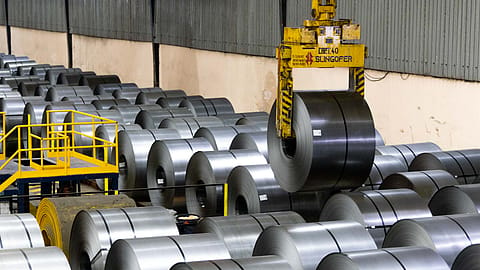JSW, Tata Steel shares rise up to 4% as DGTR initiates probe on steel imports
Indian Steel Association seeks imposition of safeguard duty on steel imports.

Shares of JSW Steel rose as much as 4% in intraday trade on Monday while that of Tata Steel were up 2% after the commerce ministry’s Directorate General of Trade Remedies (DGTR) started a probe into imports of non-alloy and alloy steel flat products.
Reacting to the development, the JSW Steel stock rose 3.5% to hit a high of ₹950.80 on the BSE. Share of Tata Steel increased 2.09% to ₹143.80 on the BSE.
This comes after Indian Steel Association, which comprises ArcelorMittal Nippon Steel, JSW Steel, Bhushan Power & Steel, Jindal Steel & Power and Steel Authority of India Ltd, sought imposition of safeguard duty on steel imports. The industry body alleged that there is a recent, sudden, sharp, and significant increase in the volume of imports, which has caused significant injury to the domestic industry in India. It further alleges that imports have taken place in such increased quantities and under such circumstances as to cause or threaten to cause serious injury to the domestic industry.
ISA has sought imposition of safeguard duties to protect the domestic industry. It has requested for the imposition of provisional measures citing the existence of critical circumstances. ISA also requested imposition of safeguard measures for a period of four years.
"Prima facie, after examining the accuracy and adequacy of the evidence provided in the application, the Authority, is satisfied that sufficient evidence exists that there is a recent, sudden, sharp and significant increase in volume of imports as a result of unforeseen developments causing serious injury and a threat of serious injury to the domestic industry," says the Directorate General of Trade Remedies.
Economic activity and urbanisation are expected to boost demand for steel in India to around 240-260 million metric tons by 2035, a CAGR of around 6% from 2023, according to a McKinsey report on steel industry.
India will keep growing, as will many Southeast Asian countries and the Middle East. In these countries, population growth and urbanisation continue to raise the demand for infrastructure. This demand will offset the decline in steel consumption in China, where a shrinking real estate market is slowing construction activity, says the McKinsey report.
Recommended Stories
Over the last 7-8 quarters, the steel industry has faced margin pressure across the globe. As countries step up exports to address domestic surplus capacity, margin pressures are expected to continue across the world, including in India, the report says.
Global steel consumption is expected to grow from around 1,764 million metric tons in 2023 to 1,950-2,000 million metric tons in 2035, driven by India and Southeast Asia. As demand stabilises or decreases in traditional, mature markets, it will grow in emerging markets, moving the centres of demand growth. While China is expected to remain the largest steel-consuming country, new geographies could drive steel demand growth in the next decade.